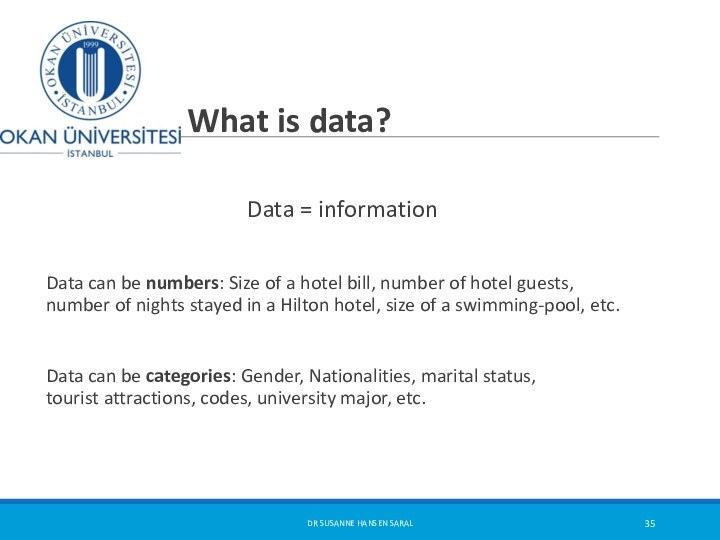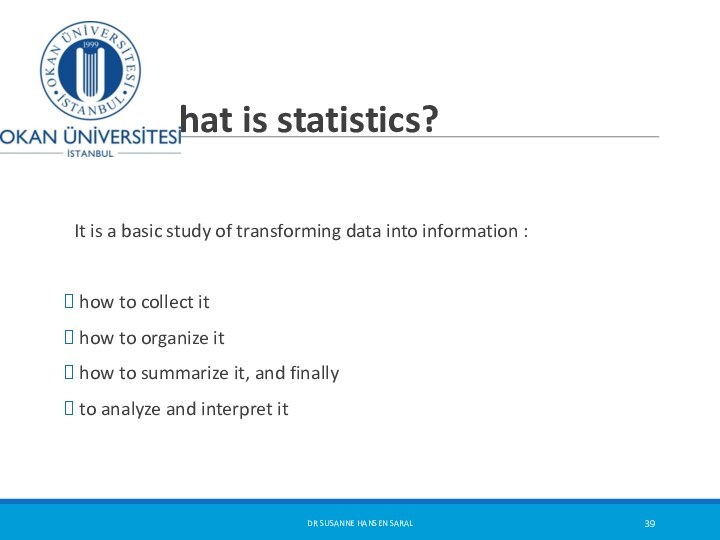A 202 IYBF-building
Office hours:
Tuesdays: 11:00 – 12:00 and 17:00 – 17:30Thursdays: 11:00 – 12:00 and 17:00 – 17:30
Email: susanne.saral@okan.edu.tr
DR SUSANNE HANSEN SARAL
FindSlide.org - это сайт презентаций, докладов, шаблонов в формате PowerPoint.
Email: Нажмите что бы посмотреть









































DR SUSANNE HANSEN SARAL
Basic course in statistical thinking and analysis. The primary goals are to help you:
Develop ability of statistical thinking and decision-making utilizing statistical tools in a context of business and management.
Acquire techniques to apply the proper current statistical tools to a broad range of business problems.
Topics covered include descriptive statistics and presentations, basic probability, various probability distributions, confidence intervals and hypothesis testing
Prerequisites: High school algebra
DR SUSANNE HANSEN SARAL
DR SUSANNE HANSEN SARAL
DR SUSANNE HANSEN SARAL
DR SUSANNE HANSEN SARAL - SUSANNE.SARAL@OKAN.EDU.TR
DR SUSANNE HANSEN SARAL
DR SUSANNE HANSEN SARAL
DR SUSANNE HANSEN SARAL
DR SUSANNE HANSEN SARAL
DR SUSANNE HANSEN SARAL
DR SUSANNE HANSEN SARAL
DR SUSANNE HANSEN SARAL
DR SUSANNE HANSEN SARAL
DR SUSANNE HANSEN SARAL
DR SUSANNE HANSEN SARAL
DR SUSANNE HANSEN SARAL
DR SUSANNE HANSEN SARAL
Ch. 1-
DR SUSANNE HANSEN SARAL
Ch. 1-
DR SUSANNE HANSEN SARAL
Ch. 1-
DR SUSANNE HANSEN SARAL - SUSANNE.SARAL@OKAN.EDU.TR
Ch. 6-
DR SUSANNE HANSEN SARAL
Ch. 1-
DR SUSANNE HANSEN SARAL - SUSANNE.SARAL@OKAN.EDU.TR
DR SUSANNE HANSEN SARAL - SUSANNE.SARAL@OKAN.EDU.TR
DR SUSANNE HANSEN SARAL
DR SUSANNE HANSEN SARAL
DR SUSANNE HANSEN SARAL
Ch. 1-
DR SUSANNE HANSEN SARAL
DR SUSANNE HANSEN SARAL
Ch. 1-
Ch. 1-
DR SUSANNE HANSEN SARAL
DR SUSANNE HANSEN SARAL
DR SUSANNE HANSEN SARAL
DR SUSANNE HANSEN SARAL
DR SUSANNE HANSEN SARAL
DR SUSANNE HANSEN SARAL